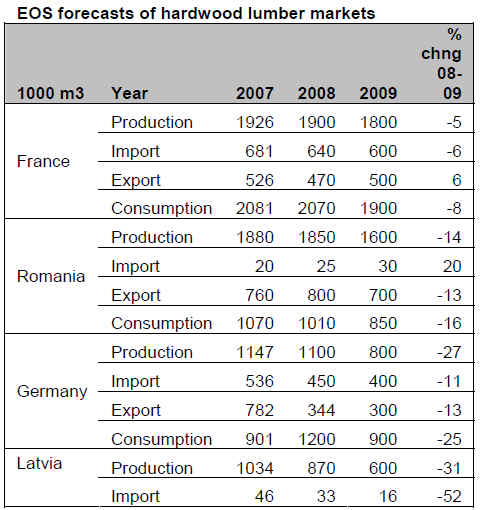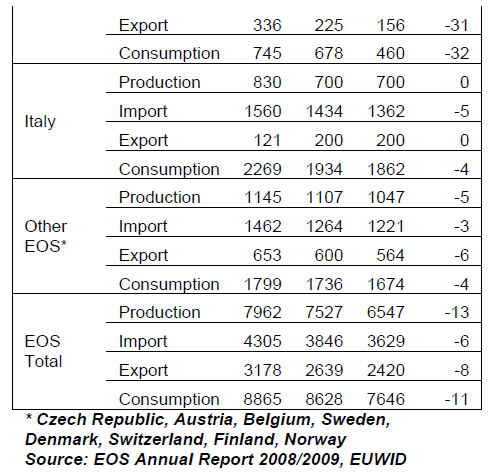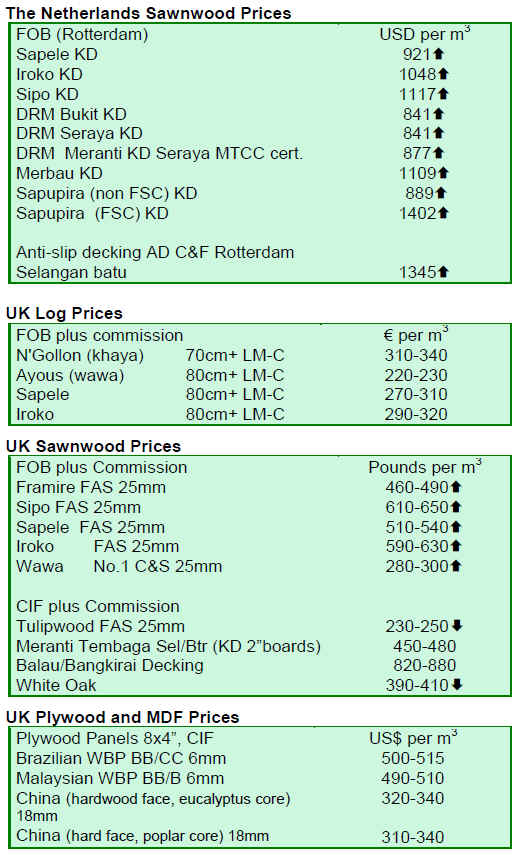|
Report
from
Europe, the UK
and
Russia
Plywood prices could be on verge of rise
After a long period of stagnant CIF NW Europe prices for
plywood products, European plywood agents believe that
CIF prices may be on the verge of significant rises.
Inflationary price pressures seem to be mounting.
Shipping lines which have been shedding money over the
last few months are laying up tonnage in an effort to drive
up freight rates. And a long period of very low harvesting
is contributing to a serious shortfall in log supplies which
has increased raw material costs in major producing
regions.
Meanwhile hardwood plywood stocks on the ground in the
EU are low following a very long period of restricted
forward buying which began in the third quarter of 2008.
There has also been a limited upturn in consumption
during the early summer months as a period of good
weather has boosted construction activity in parts of
Europe. All this has contributed to a minor increase in
forward buying in recent weeks. But the volumes involved
remain limited and no-one is expecting a dramatic increase
in the pace of forward orders any time in the near future.
In fact importers are very concerned about market
prospects during the winter of 2009/2010 when
construction activity across Europe is widely expected to
stagnate once again. In the UK, the weakness of the GBP
is another obstacle in the way of any significant increase
in forward orders.
Another factor reducing prospects for significant forward
orders is the big shift in recent years to containerization of
plywood imported into western European. The market
now tends to receive smaller volumes on a more regular
basis. This reduces the risks of ¡®boom and bust¡¯ and is
more aligned with the existing market focus on just-intime
trading.
The difficulty of obtaining credit insurance throughout the
plywood trading chain has also gummed up the European
plywood trade in recent months. Credit insurance is vital
to the smooth running of the supply chain since it gives
manufacturers insurance for the period between supplying
goods to customers and being paid for those items. If
withdrawn, suppliers may demand upfront payments from
customers or refuse to supply goods.
There are at least some signs that credit insurance is less of
an issue now than 6 months ago. Many suppliers appear to
have accepted that lack of credit insurance should not be
an over-riding factor preventing a sale. Instead suppliers
are forming their own judgements on credit worthiness
based on knowledge of the customer¡¯s long-term track
record in paying for goods.
European plywood importers have been employing two
distinct market strategies during the downturn. One group
of companies, mainly the larger and better capitalized
companies, has been trying to boost market share by
selling in volume at low margins. Another group has been
working off very low stocks and selling only limited
volumes while trying to ensure a good margin on each
sale.
Malaysia and China are jostling for position as leading
supplier of tropical hardwood faced plywood into the EU.
Indonesia is now widely regarded as a spent-force, at least
in the UK market, partly due to price but also according to
one agent ¡®because Indonesia has not properly addressed
the environmental issue¡¯. Several of the largest UK
builders¡¯ merchants continue to blacklist all Indonesian
plywood on environmental grounds.
The major focus on product price during the downturn
seems now to be having a significant impact on the quality
of plywood products supplied into the EU. There are signs
that in order to meet existing price expectations in the EU,
some plywood suppliers are cutting corners with respect to
log quality, glues and other raw materials.
Furthermore the market shift from tropical-hardwoodthroughout
plywood to combi-plywood comprising a
softwood or eucalyptus core ¨C which began several years
ago ¨C seems to have deepened. In the case of Chinese
product, there is now a shift from poplar-cores to
eucalyptus cores. There are also signs that this shift to
combi-products is now going a step further, with reports of
tropical hardwood faced plywood containing a palm or
coconut core finding its way into the market. Contacts
suggest these products have been supplied in the EU by
both Chinese and Malaysian mills. As one agent
comments ¡®the market tends to get what it pays for¡¯ and
this is an inevitable consequence of current price
expectations in Europe.
While this shift to lower value products might fit with
existing market conditions in the EU, the hardwood
plywood sector could be storing up longer-term problems.
Quality issues have already seriously dented plywood¡¯s
reputation for reliability among European manufacturers
and construction professionals. The risks of structural
weakness and fungal attack potentially associated with
these new products may make matters worse. European
importers are being advised to check carefully the
products supplied against specification.
Over the long-term, tropical hardwood plywood has lost
significant market share in certain sectors of the European
market. For example, 15 years ago tropical hardwood
plywood was used widely for interior doors and cabinets, a
niche now dominated in the EU by veneered MDF. The
good news is that there are certain niches where tropical
hardwood plywood is more difficult to substitute, for
example for heavy duty exterior construction and marine
applications. But with other materials sectors very actively
engaged in product innovation and development, no-one
can afford to be complacent.
European hardwood sawmillers predict 11% fall in
hardwood consumption
The European Organisation of Sawmillers (EOS) forecasts
that overall hardwood lumber consumption in the EOS
member countries will fall by 11% between 2008 and
2009 from 8.6 million m³ to 7.6 million m³ (see table). The
downturn in consumption is predicted to affect all EOS
member countries, although it is expected to be greatest in
Latvia (-32%), Germany (-25%), and Romania (-16%).
In 2009, France and Romania are expected to remain the
largest producers of hardwood lumber in the EOS member
countries by a significant margin. Italy is the largest
importer, followed a long way behind by France and
Germany. Overall hardwood lumber imports into EOS
countries are expected to be down 6% in 2009, again with
Latvia and Germany bearing the brunt of the decline.
The EOS membership covers most of Europe¡¯s largest
hardwood lumber producers including France, Romania,
Germany, Latvia, Italy, Czech Republic, Austria, Belgium,
Sweden, Denmark, Switzerland, Finland, and Norway.


German window market shows signs of improvement
The German trade journal EUWID reports that demand for
windows in central Europe has remained reasonably stable
over the last 6 months and that this sector has generally
outperformed other wood industry sectors since the start of
the year. EUWID notes that demand is being boosted by
good residential renovation and refurbishment activity.
However, activity in the new-build and non-residential
sector is described as stagnant. Energy-related
refurbishment projects which benefit from government
subsidies are frequently cited as the primary driver. These
projects are resulting in particularly good demand for
triple glazed units which now account for around 30% of
the total German window market.
In a related article, EUWID comment that demand for
window scantlings seems to be rising in Germany, a
development regarded by some market players as seasonal
and by others as a response to the government¡¯s second
economic stimulus package which involves extensive
investment in public sector buildings such as schools and
hospitals. EUWID also notes that standard 72X86 mm
scantlings are losing market share to thicker dimension
product. As in other sections of the European wood
market, distributors in this sector are generally looking for
product to be supplied on a little-and-often basis.
On the other hand, EUWID report that the parquet flooring
sector stagnated across Europe in the second quarter of
2009. EUWID suggest that overall demand for parquet
across the region may be as much as 20% to 30% down on
the same period last year. Demand varies widely by
country. The UK and Ireland together with southern and
eastern European countries have been very badly hit.
Demand in Germany, Austria and the Nordic countries has
been more stable. Demand is down both from retailers and
wholesale traders. The lower quality end of the market has
been particularly affected by the downturn.
 ¡¡ ¡¡
|